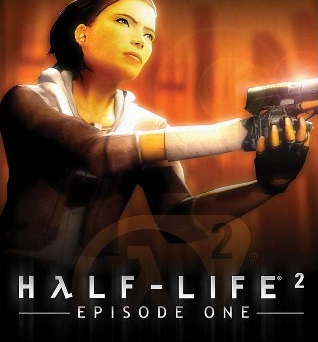Better than the original, or a lateral shift?
When playing through Half-Life 2: Episode One in the past I had always perceived it as a game that is mostly an extension of Half-Life 2. That’s not to say that it’s bad and that’s not to say that it’s good; rather, instead of a shift up or a shift down, it’s a shift sideways. After playing through it once more I feel justified in holding that view. Episode One is in a very strange realm for me. I don’t know quite where it’s meant to fit. It’s good -- it’s entertaining and it’s well designed and it improves over its predecessor in several important ways -- but that doesn’t stop it from being hard to place.
Because I just cleared Half-Life 2, it seemed to me that the logical thing to do was to steamroll on through to the episodic content. I found that Half-Life 2 holds up well today but I had a concern with Episode One, because Episode One is a very short game, it’s a very simple game, and it doesn’t bring anything new to the table, and, if anything, it’s essentially a patched version of Half-Life 2 with new goals but the same environments: literally a lateral shift, then, as opposed to a shift up or down. And that puts it in danger of becoming irrelevant, but it also means that it could just turn out to be the equal of Half-Life 2.
Episode One preserves many of the finer points of Half-Life 2. Because I have already done a write-up on Half-Life 2, I won’t repeat those points here unless they seem particularly salient or unless Episode One has built upon or amended those points. I have instead placed much revised versions of the original points in spoiler tags, but I encourage you to glance at the original text about Half-Life 2 if you are so inclined.
A note on my playthrough
Here is an approximate record of how I played through the game this time around. I kept personal notes in order to determine my playtime, and progression through the game and the like.- Play 1: 8-14-2010, 20:40 to 23:00, Chapter 1 to Chapter 4.
- Play 2: 8-15-2010, 12:00 to 12:45, Chapter 4 to Chapter 5.
My total playtime was in the region of 205 minutes, slightly under four and a half hours.
A note on the PlayStation 3
All my playthroughs of Half-Life 2: Episode One have been on the PlayStation 3. Two criticisms could be leveled here: firstly, Episode One was designed to be played on a personal computer. It was not designed for consoles. Interestingly, some parts of the game work better on consoles, but there are clearly some detriments. Primarily, aiming with joysticks is plainly not as precise as aiming with a mouse. There are other things which work in the consoles’ favor: take, for instance, the fact that platforming is reportedly less painful and much easier on consoles.Secondly, much has been made of the fact that the PlayStation 3, though still the complete Episode One experience, bears the worst version of Episode One. Perhaps this is in fact the case, but I personally find no real fault with this particular edition. Attribute this to the fact that I have played no other version; ultimately, though, I’ve experienced none of the major problems that critics have cited. Loading, for instance, is not as distressing as others would have you believe. Neither did I experience any frame-rate issues whatsoever in this particular instance of playing the game. In comparison with the majority of other PlayStation 3 games, Episode One plays proficiently and without tumult. Make of these points what you will, but I note that with those who try to claim that the PlayStation 3 version of this game is somehow unplayable or offensive, if there are such people, are incorrect.
Design
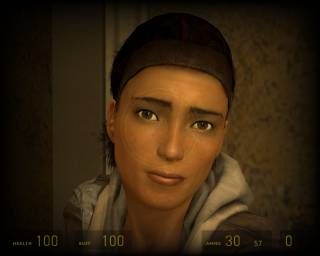
Alyx isn’t annoying
Having AI characters accompany you for 85% of any game is a fine idea. Unfortunately the majority of video game developers don’t implement buddies well. Too often characters prove to be irritating, urging you along or trying to hurry you up with canned and repetitive dialogue. Mostly they don’t do anything, and sometimes they get in the way. Valve managed to implement Alyx in the game and have her not be irksome in the least. If anything, she’s more than welcome, and Episode One would not be the same without her. Rather than nagging at the player to keep moving, she stays silent. She is functional and she is good at eliminating enemies which pose a threat. And, unlike AI buddies in Half-Life 2, she doesn’t get in the player’s way. Episode One came out in 2006 and still video games come out where AI buddy characters are some of the most infuriating parts of that game. Why, four years later, can’t other developers learn from Valve?Level design has improved over Half-Life 2
Episode One presents far fewer corridor stretches and many more large rooms in which the player can run rampant. This is most fully realized in the Citadel, but to be fair the return to City 17 sees more constraints applied as necessitated by apartment buildings and rooms and alleyways and the like. Nevertheless, the ratio between the two is well balanced and refreshing, and the design is more streamlined and less filled in by barren roads and dead corridors and empty rooms as Half-Life 2 was.There’s no getting lost anymore
It was bizarre that players could get lost in the Half-Life 2 world due to unfortunate design despite the fact that Half-Life 2 was so linear. Thankfully, no such problems ever crop up in Episode One, a game that feels just as linear as Half-Life 2 but features more open environments and stages. Valve’s engineers show clear signs of improvement with regards to level design.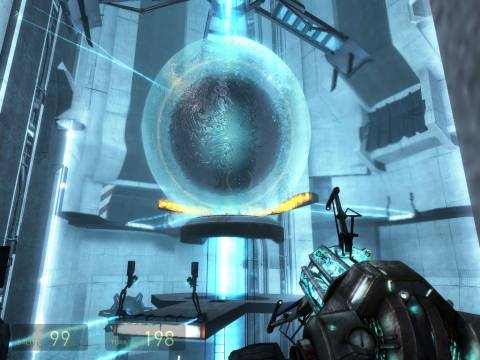
Once you’re done with an environment you’re done with an environment
I like the fact that Episode One sets you through whole environments and doesn’t force you to backtrack to get to where you were before. Take, for example, the Citadel’s core, where, once you finish with that whole environment, you don’t have to run back through a myriad of corridors and up elevators. On the contrary, when you’re finished in the core you get thrown straight back where you came from so the game can continue. Again, that’s plainly fantastic design, and a step up from where Valve came from in Half-Life 2 (if you recall places like the bridge and the two boat chapters).Commentary
As a brief aside, I like the inclusion of commentary in the game. Valve’s commentary is really well done. It manages to be both informative and interesting, even when talking about the more technical side of development. What’s most important is how the commentary is implemented. Commentary appears as speech bubble nodes throughout the world, and each instance can be activated or deactivated by aiming at it and pressing the use key. It’s simple and ingenious. Unfortunately it kind of ruins me for other games -- I would love to learn more about how development went for each and every one of my most favored games, but Episode One is one of the very rare cases where the developers are willing to give some insight.Graphics and Animation
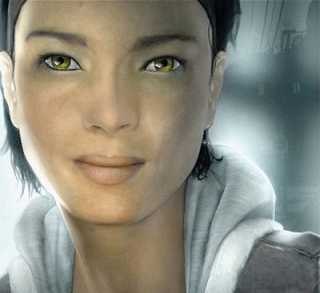
Character animation is superb
It’s fantastic to see another area of improvement over Half-Life 2, and an area so crucial for a game which integrates storytelling directly into the gameplay: there were some flaws in Half-Life 2’s animation, particularly the fact that characters would pivot while walking and talking at the same time -- that is, characters would face the player while walking, so if you stood behind characters they would walk backwards blindly along the path predetermined for them. This has been completely eliminated in Episode One. Characters now seem to prefer to stand still while talking, and if they do move, they move independently of any other beings. Animation has improved tremendously. I didn’t notice it at the time with Half-Life 2, but comparing Half-Life 2 to Episode One, Half-Life 2’s animation seems rigid, stony, like it was cut from cardboard. The characters in Episode One animate significantly more fluidly. It begins with Alyx’s first-person hug, something that passes very quickly and can almost go unnoticed (but pay attention and you’ll see that the way she grabs hold of Gordon, thrusts her head to one side and squeezes her eyes shut with joy is very convincing) and perpetuates throughout the entire game across different situations. It’s a legitimately major step up from Half-Life 2, and it makes the world become much more immersive.Facial animation is brilliant
The facial animation is still ahead of its time compared to 99% of other video games. You can ascertain the mood of a character just by looking at them. Improvements over Half-Life 2 are less noticeable than improvements in body animation because Half-Life 2’s facial animation was astounding to begin with. If anything, the expressions haven’t changed all that much, but the way they transition and animate with regards to the body is much more convincing.Gameplay
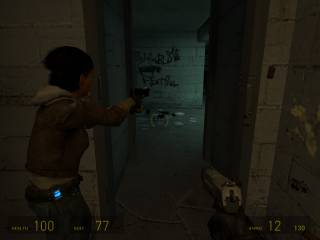
The hospital section is fantastic
The hospital section of Episode One is more than worthy of its own mention. I love the speed and the pace of the area. There’s nothing better than running through those corridors and blasting both alien creatures and Combine, and also using the environment to one’s advantage: using chairs, tables, radiators, among other things. The music also adds a whole lot to the atmosphere.Most of the weaponry is given to the player too late in the game
Having a variety of weapons is fine, but there’s no point in giving so many firearms at such a late stage in the game where there’s no use for them. For the first chapter and most of the second chapter players solely use the gravity gun. For some reason, the majority of the weapons are then dumped on in the latter half of the fifth and penultimate chapter. At that point they seem to be there only to form a full cast of weapons -- the opportunity to put the crossbow to good use is never really presented. Obviously there’s a difficulty in satisfyingly implementing all the weapons because the game is shorter than its predecessor. Considering this, perhaps some of the weapons should have been dropped, because it doesn’t feel like the magnum or the crossbow have any real place in the game.Getting out of water onto land is no longer tough
Menial problems probably have simple solutions -- this idiom is proven true by Episode One. In Half-Life 2 there was some strange issue with the player’s ability to jump out of deep water onto dry land, but this problem has been well remedied in Episode One. The game detects that the player is jumping close to land with the intention of leaving the water, so it gives Freeman’s jump an extra boost, a helping hand so to speak. It almost seems to be a patched solution rather than a change in the way the water and the way jumping is treated, but it works fine, even if it does look a little jarring.Artificial intelligence has improved slightly
Both enemy AI and ally AI was terrible in Half-Life 2. Both have been improved in Episode One. Enemies now pose a greater threat, but the majority of them are still quite prone to running directly at the character. At least they fire their weapons while doing this unlike in Half-Life 2. The “kamikaze run” phenomenon seems to be exclusive to the first two chapters -- in other words, particularly the sequences in the Citadel. By contrast, the AI is much more cogent in the Urban Flight chapter, where at least some of the hostiles – unfortunately, still a minority to be sure -- seem to hover around particular areas and take cover. Even then, they seem predisposed to charging at the player. Ally AI is significantly more improved as borne out by Alyx, but also by the resistance members. Allies now are quite capable at defending themselves when faced with a reasonable challenge (but they certainly can’t defend themselves against waves of Combine or against explosives) and they no longer trap the player in corridors as they did in Half-Life 2.Story
Great, funny writing
The writing seems to have become more chirpy, lively, and lifelike over Half-Life 2. I’m thinking of Alyx in particular and the many cracks she makes for the duration. She seems much more real and convincing than in Half-Life 2. This isn’t just limited to her asking the player for help, like asking for the flashlight to be pointed in one direction or shielding her eyes when you point the flashlight directly at her. It has to do with the way she interacts with her world and other characters. Before Dog throws the van across the chasm and into the Citadel, she claims that it’s quite a safe danger (if you’ll allow me the oxymoron) because “he’s a robot and he’s done the math”. She then whispers in his ear, “Uh… You have done the math, right?” (witness that at around 8:40 in the above video). It’s quite amusing to see Dog give a negative response. Another example, of many, is her ‘Combine + Zombie = Zombine’ gag, which is amusing and terrible at the same time, and that’s precisely the point; also her making zombie noises and totally freaking out everybody who plays the game.
Observations
Killed by the game (Undue Alarm)
Episode One marks the first time in the Half-Life universe where I’ve been killed by the game. Such phenomena are apparently not rare in Half-Life 2, yet it had never happened to me. By contrast I was killed by the game within the first ten minutes of Episode One, during the part where Dog throws the van over the hill onto the ground, and Gordon and Alyx are to board it. Unfortunately I was looking across at the Citadel at the time, and was standing square in the middle of where the van was scripted to land. Rather than squashing me, the van landed directly on top of me and seemed to spit me out laterally across the field -- literally laterally, straight as an arrow. I landed against the Citadel and fell into the chasm below. A nice introduction back into the world of Half-Life 2, then.The terrible tasks continue (Undue Alarm)
In Half-Life 2, Valve’s level designers had the player launch a boat off a ramp and drive across some very circular and very unstable pipes before trying to fit into a tiny gap after a long distance. It was a hard, frustrating, dull and daft task, and the fun continues in Episode One, where the player is required to catch giant falling pieces of rubble overhead using the gravity gun before the rubble falls and kills the player, or kills Alyx, or causes the large freight elevator (made entirely of glass, which may be aesthetically pleasing but is probably not a safe or practical design choice) to shatter and disintegrate. It wouldn’t be so bad if the game gave the player ample warning. After you catch one or two of the pieces there’s a long hiatus, and you think, ‘Well, that was probably it’. I fell into this trap despite the fact I’ve completed the game three times prior. One time Alyx said, “Gordon, heads up,” and I scarcely had the time to take my thumb off the face buttons and place it on the right analog stick -- a mere fraction of a fraction of a second -- before the large hunk of unruly metal careered straight into the elevator and my screen turned red. I am caused to wonder what the point of this entire section is. Who thought this was fun at the time? Nobody. Nobody thought it was fun. Maybe it was included because the elevator journey was too long and boring. In that case, just shorten the thing or find a way around it.The group escort seems a bit repetitive (Urban Flight)
I had to do four different escort runs, back and forth, all in the same area. It is quite true that for each run the game sets different tasks: there might be snipers or their might be hopper mines, or there might be several dropships of Combine troops. But one does grow slightly weary of the trips back and forth. I appreciate that the scope of Episode One was limited, and there probably was neither the room nor the time to make extensive, intricate levels with many layers -- an extended obstacle course, for instance, as opposed to using one short course four times. That doesn’t change the fact that this section is repetitive, however.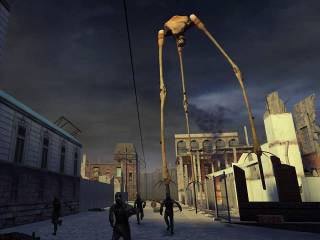
Strider battle (Urban Flight)
I really like the Strider battle that concludes the game. It’s fast, desperate, and frantic, and I’ve never had a comfortable level of health, and those poisonous black headcrabs always show up at the wrong time. I think it’s a fantastic extended set piece which is very vivid and memorable, and it’s executed superbly, save for one complaint that I have: it’s too easy to get stuck on geometry. Perhaps I don’t need to rush through it as I do, but the threat of the Strider has such an impact on me that I’m inclined to hold down that sprint button. Unfortunately Gordon seems inclined to get snagged on a wall, or on a pipe sticking out of a wall. Once in mid-sprint-jump I bumped into some pipes jutting out of a wall and fell to my death. Since the section is so frenetic, it seems a little unfair to place disruptive objects in the way.•
I said that I couldn’t quite figure out where to place Half-Life 2: Episode One, before uncomfortably concluding that it was more a lateral shift to the right as opposed to evolution or devolution from Half-Life 2. Maybe its best position is tacked on to Half-Life 2. For all those who felt the previous game’s ending was something of a non-event, then moving straight on the Episode One like it was part of Half-Life 2 is a fine strategy which few would fault. Because, again, for all intents and purposes, Episode One feels like the extra bits that Valve wanted to include in Half-Life 2 but couldn’t find the time to include or didn’t have the fleshed out story to tack these levels upon. Ultimately though, I think there’s nothing really wrong with Episode One. It probably won’t be amazing people four years later, but it’s a solid experience that’s well worth a playthrough for those who haven’t visited it for some time, but especially for those who have neglected to complete it in the first place.
